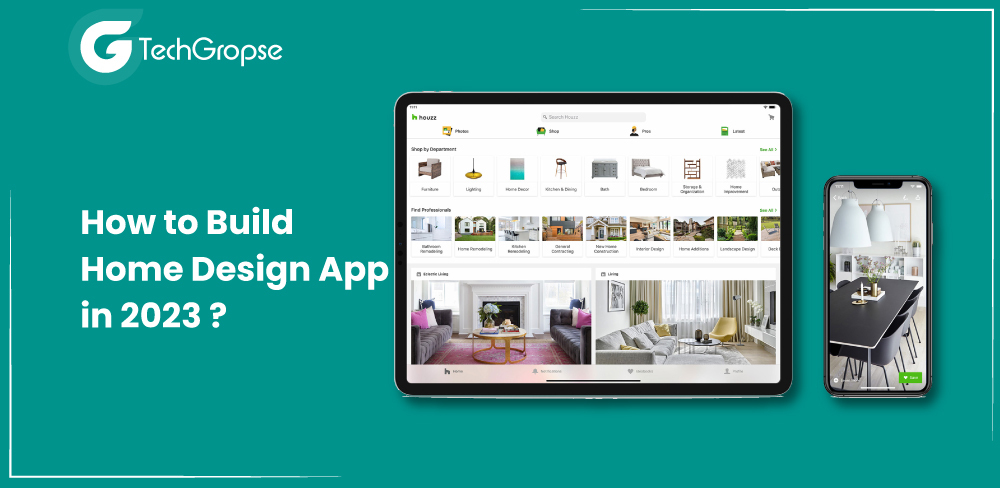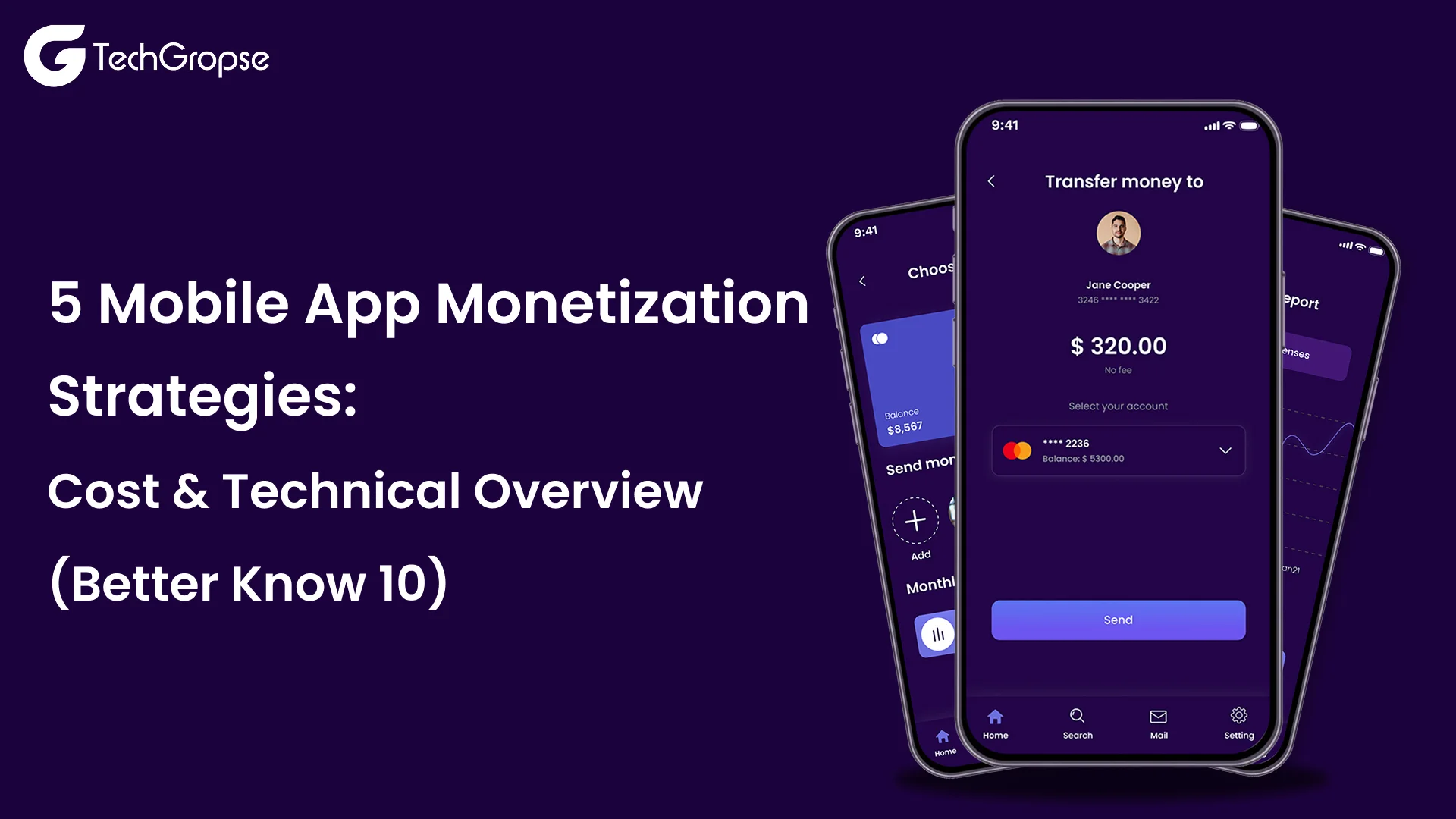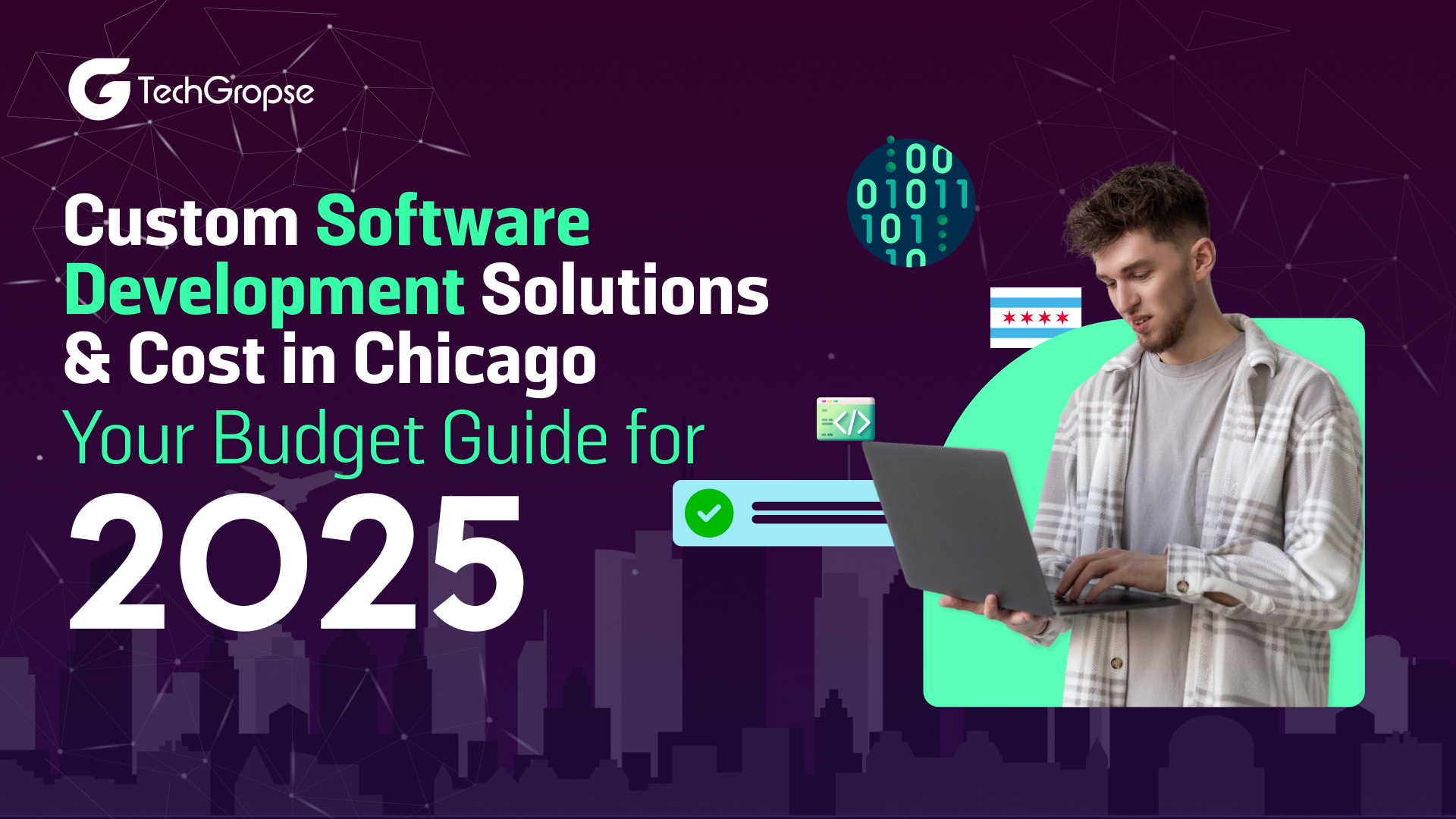Are you ready to move your dream home or build home design app? But when you go with the old method, it lacks modern technology and tools. Traditional design methods rely on manual drafting and physical blueprints, which can be time-consuming and prone to errors.
We live at the heart of this technological transformation lies the profound relief of a universal stress: the complexity and overwhelming nature of traditional home design. Home Design Apps, however, have changed the game by putting the power of design directly in the hands of the users.
On demand app development company build apps that are intuitive, user-friendly, and equipped with an amazing collection of features that simplify the entire design process. Users can experiment with various layouts, colors, materials, and furnishings and see the immediate visual impact of their choices in 3D models.
This not only empowers homeowners to take control of design aspirations but also improves collaboration between homeowners and professionals, eliminating miscommunication and fostering a more transparent and efficient design process.
This post will guide you through the process to build home design app, from understanding modern trends and demands to planning, designing, home design app development costs, and launching an app that meets the needs of users in the ever-evolving home design landscape.
The Growing Popularity of Home Design Apps
In recent years, home design apps have skyrocketed in popularity, transforming the way people envision and build their dream homes.
With just a few clicks on their smartphones or tablets, users can explore countless design ideas, experiment with different layouts, and even visualize the final look of their spaces.
This convenience and accessibility have made home design apps indispensable tools for homeowners, renters, and interior design enthusiasts alike.
- Home design is a big industry where people use special computer programs to design the insides of buildings and rooms. Experts think that by the year 2023, the market will be worth around 5.50 billion dollars.
- By 2028, they predict it will grow even more and be worth a whopping 9.46 billion dollars. They say it’s going to grow at a rate of 11.44% every year during that time.
- The study says that the market for interior design software is going to be worth a whopping US$6,872.11 million by the year 2028.
- It’s a huge jump from the US$3,337.70 million it was worth in 2020. That means it’s going to grow at a rate of 9.8% every year from 2021 to 2028.
The home design app market is filled to the brim with various options, each offering its own unique set of features and functionalities. From popular giants like Houzz and Home Design 3D to hidden gems like Roomstyler and Planner 5D, there’s something out there for everyone.
These apps come with a range of tools, including 2D and 3D floor plan creators, virtual furniture catalogs, color scheme generators, and even augmented reality options that allow you to picture how your designs would actually look in real life.
With such a wide collection of apps available, finding the perfect fit for your needs and design aspirations is just a few taps away.
Understanding the Trends and Demands in 2023
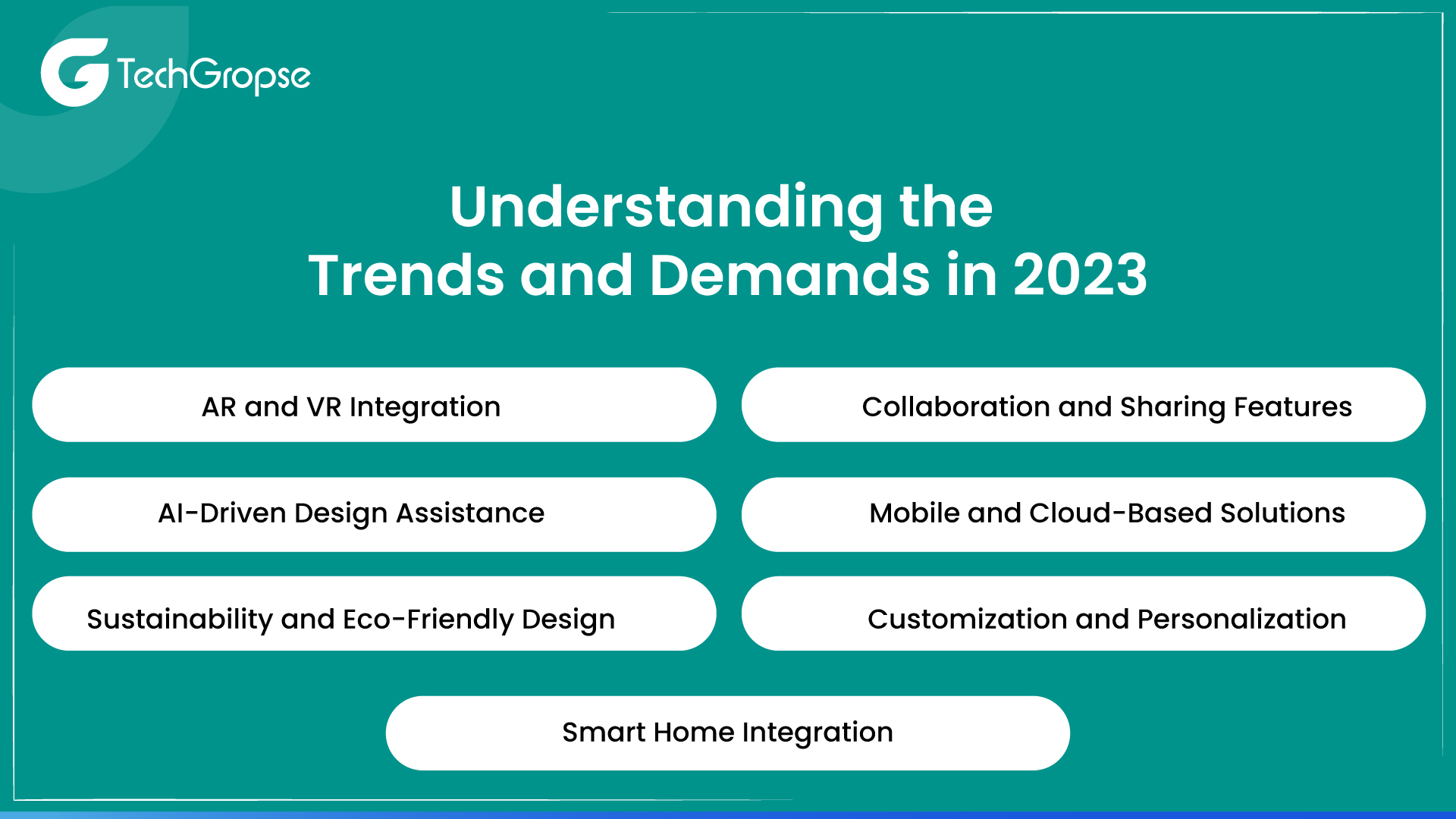
The home design app development company has the potential to grow significantly in 2023, driven by technological advancements and an increasing interest in home improvement and renovation.
Users’ demands will continue to shape the landscape of these apps, with an emphasis on user empowerment, sustainability, and innovation.
1. AR and VR Integration
Home design apps are likely to continue integrating AR and VR technologies. Users can visualize and experience their designs in a more immersive way, making it easier to make informed decisions about layouts, furniture placement, and interior design.
2. AI-Driven Design Assistance
AI-powered features to build home design apps could offer personalized design suggestions, considering users’ preferences and the latest design trends. These tools might streamline the decision-making process and enhance user experiences.
3. Sustainability and Eco-Friendly Design
As environmental consciousness grows, there will likely be an increased demand for home design apps that focus on sustainability. These apps may include features to help users make eco-friendly choices in terms of materials, energy efficiency, and waste reduction.
4. Collaboration and Sharing Features
Collaboration tools within home design apps may expand to allow multiple users, including homeowners and professionals, to work together on projects seamlessly. Sharing and co-editing functionalities could become more prevalent.
5. Mobile and Cloud-Based Solutions
Mobile compatibility and cloud-based storage are essential for flexibility. Users want to access their projects from various devices and locations, so when it comes to build home design apps it will need to prioritize synchronization and accessibility.
6. Customization and Personalization
People seek unique and personalized home designs. Apps should offer extensive customization options and access to a wide range of design elements, from furniture to color palettes, to cater to diverse tastes.
7. Smart Home Integration
With the increasing prevalence of smart home technology, home design apps may include features that help users plan and integrate smart devices and systems into their home designs.
Step-By-Step Guide to Build Home Design App
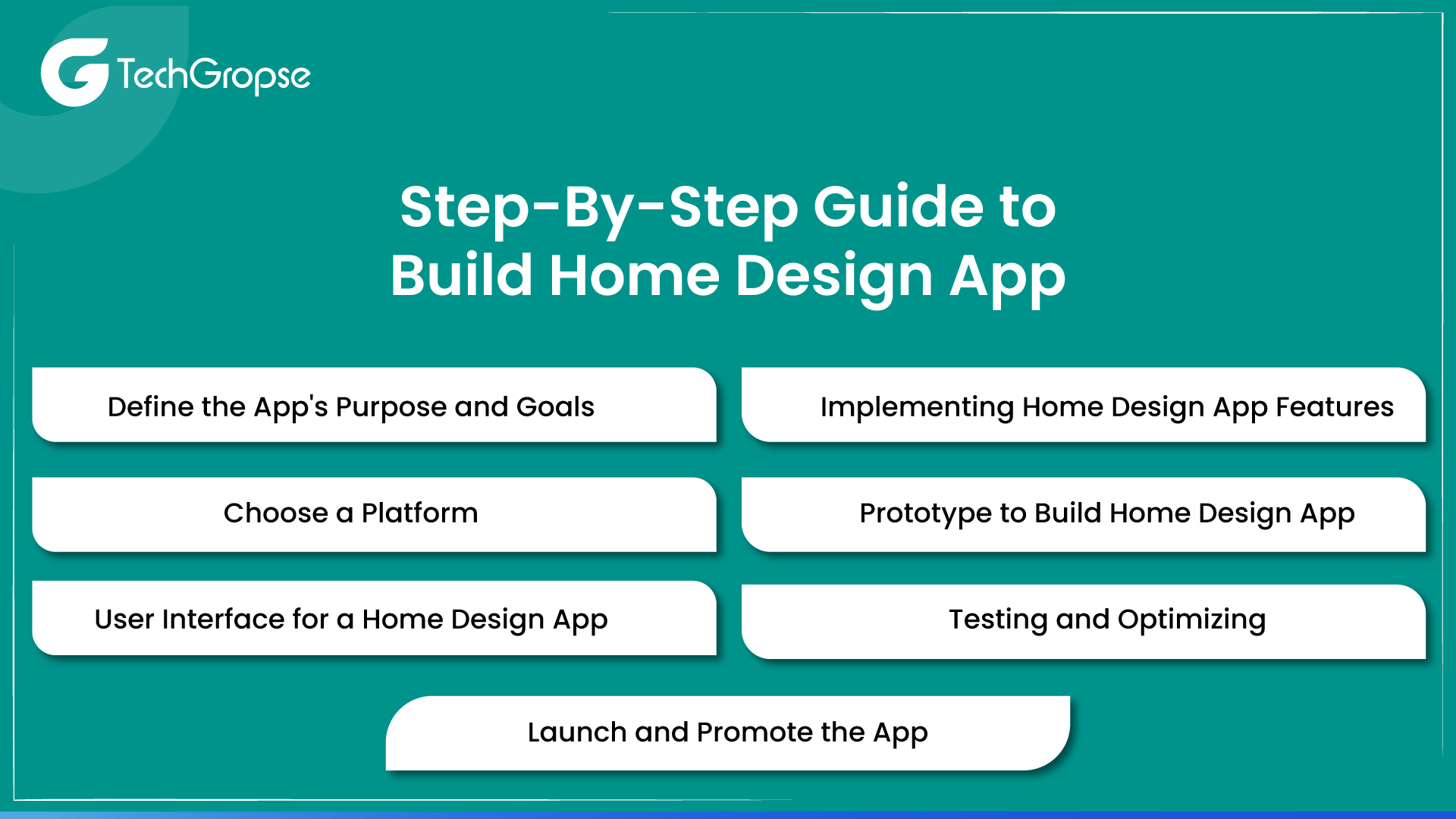
With the advancement of technology and the increasing interest in designing homes on their own, many people are looking for a seamless and efficient way to design their homes.
A home design app is one of the best solutions for this purpose, and it has become increasingly popular over the years.
If you want to build home design app it can be quite a challenge, and you can consult with a mobile app development company that follows a comprehensive approach that takes into account the app’s purpose, the platform, the tools, and the development process.
Step 1: Define the App’s Purpose and Goals
Before starting any development process, it is important to determine the app’s purpose and goals. To achieve the best outcome, you need to identify the features the app should have, the problems it should solve, and what unique value it provides to users.
A home design app can be designed for different purposes, such as designing a new home, renovating an existing one, or reorganizing a room layout. Each of these different purposes will require features that are specific to that need.
Therefore, it is important to determine the app’s primary function and target audience in order to meet the user’s needs.
Step 2: Choose a Platform to Build Home Design App
The next step in building a home design app is to determine which platform it will be developed for. Hire dedicated developers who can be developed for either one or both of the main platforms, Android and iOS. However, the platform you choose will have a significant impact on the tools you need and the development process.
Android is the world’s most popular mobile platform with more than two billion active users. Android apps are developed using Java or Kotlin programming languages and are compatible with a wide range of devices.
However, Android has a more fragmented ecosystem, with a wide range of screen sizes and resolutions, which can make designing the app harder.
On the other hand, iOS has a smaller but more dedicated user base. iOS apps are developed using Objective-C or Swift programming languages and are compatible with a smaller pool of devices.
However, iOS has a more consistent ecosystem, with fewer device types and screen sizes, which can make designing the app easier.
Step 3: Select a Development Approach
Once the platform has been chosen, it is important to decide on the development approach to build home design apps. There are two primary approaches to building apps – native and hybrid development.
1. Evaluating Different Technology Options
When it comes to building a home design app, choosing the right technology stack is vital. Consider an Android app development company that focuses on essential factors like scalability, performance, and compatibility with different platforms.
| Cross-Platform Development | Native App Development |
| React Native | Swift (for iOS) |
| Flutter | Kotlin (for Android) |
2. Considerations for Backend Technology
The backend of your home design app plays a crucial role in storing user data, managing accounts, and facilitating real-time collaboration. Choose a reliable and scalable backend technology stack that can handle heavy traffic and ensure data security.
Popular options include
- Node.js
- Django
- Ruby on Rails
3. Selecting the Appropriate Frontend Framework
The front end of your home design app is what users interact with, so choosing the right framework is essential for a seamless user experience. Options like
- React
- Angular
- Vue.js
All are popular choices due to their flexibility, robustness, and vibrant developer communities. Remember that Android app development cost depend on your requirements.
Step 4: Creating an Intuitive User Interface for a Home Design App
1. Principles of effective UI/UX design
When it comes to build home design apps, having an intuitive user interface (UI) is crucial. You want your users to be able to easily navigate the app and find the features they need without feeling overwhelmed.
Here are some principles of effective UI/UX design to keep in mind:
- Simplicity is key: Avoid cluttering the interface with unnecessary elements. Keep it clean and organized, allowing users to focus on the task at hand.
- Consistency matters: Use consistent design patterns and visual cues throughout the app. This helps users quickly understand how different elements function.
- Clear and concise labeling: Use descriptive labels that are easy to understand. Avoid jargon or confusing terminology, and consider using icons to supplement text labels.
- User feedback and responsiveness: Provide visual feedback to let users know their actions have been recognized. This can be as simple as changing the color of a button when it’s pressed.
2. Designing a User-Friendly Navigation System
Navigating through a home design app should be a breeze for users. Here are some tips for designing a user-friendly navigation system to build home design apps:
- Clear hierarchy: Prioritize the most important features and make them easily accessible. Use visual cues like size, color, and position to indicate importance.
- Logical grouping: Organize features and functions into logical groups. For example, place all the tools related to drawing floor plans in one section, and those for choosing materials in another.
- Smart search functionality: Implement a robust search feature that allows users to quickly find specific items like furniture or fixtures.
- Use familiar patterns: Stick to familiar navigation patterns, such as bottom tabs or a hamburger menu. It helps users feel comfortable and reduces the learning curve.
3. Optimizing the User Interface for Different Devices
In today’s world, people use various devices, including smartphones, tablets, and desktops. To ensure a seamless user experience, optimize your home design app’s user interface for different devices.
Consider the following:
- Responsive design: Create a flexible layout that adapts to different screen sizes. This ensures that your app looks and functions well on devices of all sizes.
- Thumb-friendly design: Design with mobile users in mind. Place frequently used buttons and controls within easy reach of the user’s thumb to enhance usability.
- Performance optimization: Prioritize performance optimization to ensure smooth operation on devices with varying processing power.
Step 5: Implementing Home Design App Features
1. Designing a Seamless Floor Plan Creation Tool
Creating floor plans is a fundamental aspect to build home design app. To design a seamless floor plan creation tool:
- Intuitive drawing tools: Provide users with easy-to-use drawing tools, such as drag-and-drop functionality and grid snapping, to help them accurately create floor plans.
- Real-time measurements: Allow users to see the dimensions of their floor plan as they are drawing, making it easier to visualize and adjust the layout.
- Customization options: Enable users to add specific details to their floor plans, such as doors, windows, and furniture.
2. Implementing Realistic 3D Rendering Capabilities
Realistic 3D rendering can give users a more immersive experience while designing their homes. Consider the following when implementing this feature:
- High-quality graphics: Utilize modern rendering technologies to create visually appealing and realistic 3D models of homes, furniture, and decor.
- Lighting and shading effects: Implement lighting and shading effects to bring the 3D models to life, adding depth and realism to the virtual environment.
- User-friendly controls: Allow users to interact with the 3D models, such as zooming, rotating, and panning, to explore different angles and perspectives.
3. Incorporating Virtual Reality and Augmented Reality Features
Virtual reality (VR) and augmented reality (AR) can take the home design experience to the next level. Consider incorporating these features to provide users with immersive experiences to build home design app:
- Virtual walkthroughs: Use VR technology to allow users to virtually walk through their designed homes, giving them a realistic preview of the space.
- AR measurements: Implement AR capabilities to enable users to measure dimensions and visualize how furniture or objects would fit into their physical space.
- Interactive design changes: Allow users to make real-time changes to their designs using AR, letting them see how different options look in their actual environment.
Step 6: Prototype to Build Home Design App
Before starting the full development process, it is important to create wireframes or prototypes of the app to determine the user interface and user experience. This will help you identify potential issues in the app’s design and make improvements before investing time and resources in the full development process.
You can use tools like
- Sketch
- Figma
- Adobe XD
Wireframes are basic designs that show the structure of the app’s screens and their interactions. They are not intended to be detailed or finalized designs, but rather a means of visualizing the app’s functionalities and flows.
With wireframes, you can test and refine your ideas, get feedback from stakeholders, and improve the user experience. Prototypes, on the other hand, are more advanced models of the app that simulate interactions and the user experience.
Prototypes can be created using different levels of fidelity, from basic clickable designs to fully functional interfaces with animations and dynamic content. Prototyping allows you to validate your ideas, test different designs, and refine the app’s functionality.
Step 6: Testing and Optimizing a Home Design App for Performance
1. Importance of Thorough Testing in a Home Design App
Testing is a crucial step in building a successful home design app. Thorough testing helps ensure that the app performs well, is stable, and provides an excellent user experience.
Pay attention to the following areas during testing:
- Functionality: Test all features to make sure they work as intended and don’t produce any errors or crashes.
- Performance: Evaluate the app’s performance on different devices and operating systems. Optimize loading times, responsiveness, and resource usage.
- Compatibility: Test the app on various devices, screen sizes, and resolutions to ensure visual elements and functionalities adapt well to different configurations.
2. Performance Optimization Techniques for Better User Experience
To optimize your home design app’s performance and enhance the user experience:
- Efficient resource management: Optimize the app’s resource usage, such as memory and processing power, to ensure smooth performance even on low-end devices.
- Caching and data management: Implement smart caching techniques to reduce load times and minimize data usage. Store frequently accessed data locally to improve responsiveness.
- Code optimization: Review your app’s code and identify areas for optimization. Streamline algorithms and eliminate unnecessary computations to enhance performance.
3. Conducting User Testing and Gathering Feedback
User testing and feedback are invaluable in improving your home design app. Engage real users to provide feedback on their experiences and iterate on your app based on their insights:
- Usability testing: Observe users as they interact with your app and gather feedback on what works well and what can be improved. This helps identify usability issues and uncover areas for optimization.
- Feedback channels: Provide users with an easy way to provide feedback. It can be via email, in-app feedback forms, or social media. Energetically listen to their advice and implement changes accordingly.
- Continuous improvement: Keep iterating on your app based on user feedback. Regularly release updates that address issues and incorporate new features that users desire.
Step 8: Launch and Promote the App
Once the development process is complete, it is time to launch your app and start promoting it to gain traction.
Launching the app involves publishing it to the App Store or Google Play Store, which requires specific technical knowledge and careful attention to the platform’s guidelines and requirements.
Marketing your home design app is crucial to reaching your target audience and driving user adoption. Here are some key aspects of creating a compelling app marketing strategy:
- Define your target audience: Identify who your app is designed for and tailor your marketing efforts accordingly. Determine their pain points and highlight how your app solves them.
- App store optimization (ASO): Optimize your app’s listing on app stores by using relevant keywords, compelling descriptions, and captivating screenshots. This helps improve visibility and attract more potential users.
How Much Does it Cost to Build Home Design App?
The mobile app development cost can vary widely depending on factors such as features, complexity, platform, location of development, and more.
Here’s a table with estimated cost ranges for developing a home design app:
| Development Stage | Cost Range |
| Market Research and Planning | $5,000 – $10,000 |
| UI/UX Design | $10,000 – $30,000 |
| Frontend Development | $30,000 – $100,000 |
| Backend Development | $20,000 – $60,000 |
| Integration of Features | $15,000 – $50,000 |
| Testing and Quality Assurance | $10,000 – $25,000 |
| Security and Privacy Measures | $5,000 – $15,000 |
| Deployment and Distribution | $5,000 – $10,000 |
| Marketing and Promotion | $15,000 – $50,000 |
| User Support and Maintenance | $20,000 – $50,000 per year (ongoing) |
| Total Estimated Cost | $135,000 – $360,000+ (excluding ongoing costs) |
6 Popular Home Design Applications in 2023
| Home Design App | Description | Interesting Features |
| 1. Houzz | Houzz is a popular platform that offers a wide range of interior design ideas and allows users to visualize their own designs. | – Extensive database of interior design photos and ideas.
– Augmented Reality (AR) feature to preview products in your space. – Directory of local professionals for hire. |
| 2. Planner 5D | Planner 5D is an easy-to-use design tool for creating floor plans and interior designs in both 2D and 3D. | – Drag-and-drop design interface.
– Access to a wide library of decor items and furniture. – Real-time 3D rendering. |
| 3. Home Design 3D | Home Design 3D is a user-friendly app that allows you to create and furnish your home in 3D, from floor plans to interior decoration. | – Intuitive 2D and 3D design tools.
– Augmented Reality (AR) mode for visualizing designs in real spaces. – Collaborative features for sharing projects. |
| 4. SketchUp | SketchUp is a 3D modeling tool used by professionals for architectural and interior design. It offers a free version known as “SketchUp Free.” | – Advanced 3D modeling capabilities.
– A vast library of user-created 3D models. – Integration with 3D Warehouse for resources. |
| 5. MagicPlan | MagicPlan is unique in that it allows you to create floor plans by scanning your space with your device’s camera. | – Scan rooms and create floor plans quickly.
– Automatic room and wall dimension measurements. – Integration with furniture catalogs. |
| 6. Homestyler | Autodesk’s Homestyler provides an easy way to visualize your interior design ideas. It offers both mobile and web versions. | – 2D and 3D design tools with real-time rendering.
– Integration with Autodesk products. – Social sharing and design community. |
Closing Words
As we are aware to build home design app can be a complex and challenging process, but with the right approach and tools, it can result in a seamless and efficient user experience.
To build a home design app in 2023, you need to hire Android app developers, define the app’s purpose and goals, choose the platform and development approach, prototype the app, develop it, launch it and promote it, and gather feedback to improve it.
By following these steps and working with a skilled development team, you can create a successful app that meets your users’ needs.
FAQ: How to Build Home Design App in 2023
1. Can I build a home design app without any coding experience?
While having coding experience can be beneficial, it is not always necessary to build home design app. There are user-friendly app development platforms and tools available that allow you to create an app without extensive coding knowledge.
2. What are some monetization options for a home design app?
There are several monetization options you can explore to build home design app. These include offering in-app purchases for premium features or content, implementing a subscription model with different tiers of access, displaying advertisements within the app, or partnering with furniture and decor brands for affiliate marketing opportunities.
3. How can I effectively market my home design app?
Effective marketing is crucial for the success of your home design app. Start by identifying your target audience and their preferred channels of communication. Utilize social media platforms, online advertising, content marketing, and influencer partnerships to create awareness and generate interest in your app.

Hello All,
Aman Mishra has years of experience in the IT industry. His passion for helping people in all aspects of mobile app development. Therefore, He write several blogs that help the readers to get the appropriate information about mobile app development trends, technology, and many other aspects.In addition to providing mobile app development services in USA, he also provides maintenance & support services for businesses of all sizes. He tried to solve all their readers’ queries and ensure that the given information would be helpful for them.






